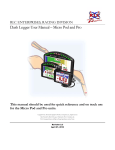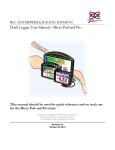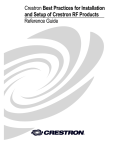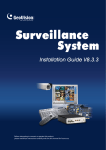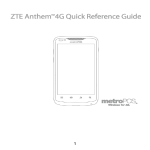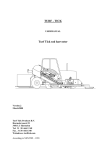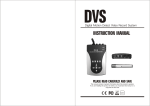Download WiPry-Combo Manual - Interworld Electronics
Transcript
WiPry-Combo Manual Innovation for Inventors Table of Contents Spectrum Analzyer Dynamic Power Meter Section 1 Getting Started with SAFETY Section 5 How WiPry-Power Works 1.20 Getting Started with SAFETY 1.30 Compatibility 5.20 Power Meter 1.10 Quickstart Guide 1.31 Hardware 1.32 Software Section 2 How Spectrum Analyzer Works 2.10 Menus 2.20 Spectrum Views 2.21 Real-Time View / Waterfall View 2.22 Raw 2.23 Hold / Decay 2.24 Average 2.25 Int. Atten. / Ext. Atten. 2.26 Clear Waveforms 2.30 Cursors 2.31 On / Off 2.32 Axis 2.33 Mode 2.34 Horizontal Cursors 2.35 Vertical Cursors 2.40 Measurements 2.50 Colors 5.10 Menus 5.21 Int. Atten. 5.22 Ext. Atten. 5.23 Reference wave 5.30 Cursors 5.31 On / Off 5.32 Axis 5.33 Mode 5.34 Horizontal Cursors 5.35 Vertical Cursors 5.40 Measurements 5.50 Trigger 5.51 RF Triggering 5.52 Digital Triggering 5.53 Auto vs. Normal 5.54 Delay 5.55 Holdoff 5.56 Single- shot Waveform Capture 5.60 Demo 5.70 Settings 5.71 Grid Settings 5.72 Alerts 5.73 Persistence 5.74 Sounds 5.75 Units 5.76 Screenshot 5.77 Email 5.78 Manage Data Log 5.79a Configuration Settings 5.79b Pause / Play 2.60 Demo 2.70 Settings 5.80 Host Properties 2.51 Real Wave 2.52 Heat Map 2.53 Decay 2.54 Average 2.55 Max Hold 2.56 Min Hold 2.71 Grid Settings 2.72 Alerts 2.73 Sounds 2.74 Units 2.75 Screenshot 2.76 Email 2.77 Manage Data Log 2.78 Configuration Settings 2.80 Pause / Play 2.90 Host Properties Section 3 Switching Spectrum Mode to Power Mode Section 4 Spectrum Analyzer Performance 4.10 Detailed Specifications Section 6 Switching Power Mode to Spectrum Mode Section 7 Product Warranty & Accessory 7.10 Manufacturers Warranty 7.20 Optional Conducted Measurement Kit Section 8 Power Meter Performance 8.10 Detailed Specifications 8.20 Performance Optimization Section 9 How to Contact Us Section 1 Getting Started with SAFETY 1.10 WiPry-Combo Quickstart Guide The quickstart guide listed below applies for both the spectrum analyzer and the dynamic power meter. Quickstart Guide WiPry-Combo Spectrum Analyzer & Dynamic Power Meter 30 PIN DOCK CONNECTOR CONNECT TO APPLE DEVICE WA R N I NG DO NOT APPLY MORE THAN 20dBm TO THE ANTENNA WITHOUT EXTERNAL ATTENUATION 2.4GHz - 2.5GHz ANTENNA ACCESSORY WA R N I NG DO NOT APPLY MORE THAN -0.5/+3.8 V TO THE EXTERNAL TRIGGER EXTERNAL TRIGGER (OPTIONAL) 1) Connect Antenna and External Trigger (optional) to the appropriate ports. 2) Download “WiPry” from the App Store. 3) Connect accessory to the iPod touch®, iPhone®, or iPad™ using the 30 pin dock connector. 4) For more information, please visit the Oscium website. www.oscium.com “Made for iPod”, “Made for iPhone”, and “Made for iPad” means that an electronic accessory has been designed to connect specifically to iPod, iPhone, or iPad, respectively, and has been certified by the developer to meet Apple performance standards. Apple is not responsible for the operation of this device or its compliance with safety and regulatory standards. Please note that the use of this accessory with iPod, iPhone, or iPad may affect wireless performance. Revised November 17, 2011 3 WiPry-Combo Manual 1.20 WiPry-Spectrum SAFETY Do not apply more than 20dBm to the antenna without attenuation. Oscium is not held liable for usage outside of these limits. 1.30 Compatibility 1.31 Hardware WiPry works on these specific Apple® devices: iPod touch (1st, 2nd, 3rd and 4th generation) iPhone 4S iPhone 4 iPhone 3GS iPhone 3G iPhone iPad 2 iPad 1.32 Software WiPry is compatible with all generations of the iPod touch, iPhone, and iPad devices running iOS version 3.1.3 or higher. Three distinct products are available under the WiPry brand: WiPry-Spectrum, WiPry-Power, and WiPry-Combo. Once hardware is connected, the system will automatically recognize whether it is the spectrum analyzer (WiPry-Spectrum) or the power meter (WiPry-Power) or both (WiPry-Combo). The connected hardware will enable the appropriate functionality. If hardware has not been detected, demo mode will simulate data. Test drive the software for free by downloading WiPry from the Apple App Store. Revised November 17, 2011 4 Section 2 How WiPry-Spectrum Works 2.10 Menus The section of the manual describes how the spectrum analyzer portion of WiPry-Combo works on the iPad, iPhone and iPod touch. iPad | iPhone | iPod Double clicking on the display will toggle between: the menu bar and the summary bar. The Menu Bar The Summary Bar The menu bar has sub menus that can be activated by touching the appropriate word or icon. When using the iPad and hardware is not connected, the following options exist in the menu bar: When hardware is plugged into the iPad, the demo option disappears. On the iPhone / iPod touch, the same options exist in demo mode except that the settings option is not viewable. To view settings in demo mode, press and hold and it will change to . To toggle between spectrum analyzer mode and power meter mode, touch the menu bar to change the mode. or in the bottom right corner of Revised November 17, 2011 5 WiPry-Combo Manual iPad | iPhone | iPod 2.20 Spectrum Views 2.21 Real-Time View / Waterfall View Touch on the menu bar. At the top of the menu, the waveform can be set to either real wave or waterfall by touchping either or . When activated, it will change from to . When real wave is selected, six additional views are available: Raw, Decay, Average, Max Hold, Min Hold, and Heat Map. To scroll through the measurement options, touch . Then, scroll through the pick wheel to choose the desired measurements. To activate the settings touch away from the menu or touch . 2.22 Raw Touch on the menu bar, then touch and scroll through the pick wheel until it RAW is highlighted. To activate the raw view, touch away from the menu or touch . 2.23 Hold / Decay Touch on the menu bar. In the default setting should be selected. Once decay is activated both the advanced options for hold and decay will be activated. To change the advanced option touch and swipe the dot to the right of either hold or decay . While decay is activated, it is also possible to simultaneously select any two other real-time views. 2.24 Average Touch on the menu bar. In the default setting should be selected. When selected, an advanced sliding bar is then activated below. To change the advanced options, touch and swipe the dot to the right of average . 2.24 Int. Atten. / Ext. Atten. Touch to the right of on the menu bar. To change the Internal Attenuation (Int. Atten.) level, touch . Enter the desired value using the pick wheel. To activate the setting touch away from the menu or touch . To change the External Attenvation level the same procedure should be followed. Touch to the right of . Enter the desired value using the pick wheel. To activate the setting touch away from the menu or touch . 2.25 Clear Waveforms To clear waveforms, touch on the menu bar. Then touch, . 2.30 Cursors 2.31 Cursors On / Off Touch on the menu bar. Touch to activate cursors. With real-time wave views, it is possible to select either Revised November 17 , 2011 6 iPad | iPhone | iPod horizontal or vertical cursors. With the waterfall view, both the horizontal and the vertical cursors will be activated. 2.32 Cursor Axis Touch either the cursor or the cursor. Double tap the interface until the summary screen appears. Metrics relating to the cursors appear in the center of the summary screen. 2.33 Cursor Mode There are two modes available on this device: and . Upon activating cursors, two lines will appear. One is dotted and the other is solid. The solid line is active and can be moved, while the dotted line is stationary (unless the cursors are in tracking mode). While in tracking mode both the solid and dotted lines will move together. In independent mode the solid line is the only line that can be moved. Additionally, dynamic metrics related to the solid line are available in the summary screen located at the bottom. Touch on the dotted line and it will become a movable line, while the other line will change to dotted. solid 2.34 Horizontal Cursors Touch the icon from the menu bar. Touch to activate cursors. Touch from the cursors menu and it will change from to turn the horizontal cursors on and off, respectively. to . Touch and On the main screen, touch and swipe the desired cursor in the vertical direction and place where desired. The selected cursor will be displayed as a solid line and the un-selected cursor, a dotted line. The position of the selected cursor is indicated next to @dBm or @mW in the summary bar. The distance between the two cursors is indicated next to ∆dBm or @mW in the summary bar. If cursor data is to be displayed in Base, touch the current unit of time. . The image next to the word UNIT allows you to view If cursor data is to be displayed as a ratio, touch . The options next to the phrase 100% WITHIN set the ratio. Ratio settings available next to 100% WITHIN include: . The option of sets 100% within the screen divisions or grid divisions. The option sets 100% between the two cursors. 2.35 Vertical Cursors Touch the icon from the menu bar. Touch to activate cursors. Touch from the cursors menu. On the main screen, touch and swipe the desired cursor in the horizontal direction and place where desired. The selected cursor will be displayed as a solid line and the un-selected cursor, a dashed line. The position of the selected cursor is indicated next to @Hz in the summary bar. The distance between the two cursors is indicated next to ∆mW (or ∆dBm) in the summary bar. The point where the selected cursor crosses the spectrum waveform is indicated in the summary bar next to @dBm. The vertical difference between the crossing points of the two vertical cursors is indicated in the summary bar next to ∆dBm. When using vertical cursors both @Hz, Hz and @dBm, dBm or @mW, mW will be visible in the summary bar. Revised November 17, 2011 7 WiPry-Combo Manual iPad | iPhone | iPod Verify that cursors are selected. To move cursors independently of one another, touch cursors as a single unit with a fixed distance between them, touch The following options are available: 1.If cursor data is to be displayed in Base, touch Time settings available in the Base option include: option sets the unit of measure in hertz. 2. If cursor metrics are to be displayed in Phase, touch phase. The option of . To move . . . The options next to the word UNIT set the unit of time. . The option sets the unit of measure in seconds. The sets 360° within 5 divisions. The . The options next to the phrase 360° WITHIN sets the option sets 360° between the two cursors. 3. If cursor data is to be displayed as a ratio, touch . The options next to the phrase 100% WITHIN set the ratio. Ratio settings available next to 100% WITHIN include: . The option of sets 100% within 5 divisions. The option sets 100% between the two cursors. 2.40 Measurements Touch from the menu bar. Four different peak measurements exist: Peaks (On Top), Peaks (Decay), Peaks (Avg.) and Peaks (None). To change any of the measurements, touch and swipe the dot to the right of the text. To change Peaks (on top), touch . Six options exist: None, Raw, Decay, Average, Max Hold, and Min Hold. Select the desired option by scrolling through the pick wheel; to activate the settings touch away from the menu or touch . 2.50 Colors 2.51 Real Wave Touch . Then touch Either or in the menu. Then select the desired color using the color palette. To activate the settings touch away from the menu or touch . To clear the setting, touch . To select the desired color threshold, touch next to either Min or Max. Then select the desired units using the pick wheel. To activate the settings touch away from the menu or touch . Revised November 17 , 2011 8 iPad | iPhone | iPod The threshold level is controlled with located on the far right of the screen. Touch and drag the bubble either up or down in order to manually change the threshold. A horizontal line and will then appear to the right of . Also, the interface will show a color gradient using the selected colors for Min and Max. To set the colors to a default Rainbow setting touch . When Rainbow is selected it will look like and both Min and Max will be grayed out. To personalize Raw Wave colors touch either or and select a color from the pick wheel. To reset colors to default touch . 2.52 Heat Map Touch . Then touch either , or in the menu. Then select the desired color using the color palette. To activate the settings touch away from the menu or touch . To clear the setting, touch . To select the desired color threshold, touch next to either Min, Mid or Max. Then select the desired units using the pick wheel. To activate the settings touch away from the menu or touch . Revised November 17, 2011 9 WiPry-Combo Manual iPad | iPhone | iPod To set the colors to a default Rainbow setting touch . When Rainbow is selected it will look like Mid, and Max will be grayed out. To personalize Raw Wave colors touch either , or color from the pick wheel. To reset colors to default touch and Min, and select a . 2.53 Decay Touch . then touch next to the phrase palette. To activate the settings touch away from the menu or touch . Then select the desired color using the color . To clear the setting, touch . 2.54 Average Touch . Then touch next to the phrase wheel. To activate the settings touch away from the menu or touch . Then select the desired setting in the pick . To clear the setting, touch . 2.55 Max Hold Touch . Then touch next to the phrase wheel. To activate the settings touch away from the menu or touch . Then select the desired setting in the pick . To clear the setting, touch . Revised November 17 , 2011 10 iPad | iPhone | iPod 2.56 Min Hold Touch . Then touch next to the phrase wheel. To activate the settings touch away from the menu or touch . Then select the desired setting in the pick . To clear the setting, touch . 2.60 Demo Touch . Four different settings exist: NONE, WiFi, DECT, and DSSS. Once a setting is selected it will change from to . 2.70 Settings 2.71 Grid Settings Lines vs. Dots Touch . Then touch the desired selection either or . This setting affects the way that the signals are displayed; it will either be point by point (dots) or it will be represented with a line. Graticule Touch . Then touch or to scroll through the various background display options. They include: Crosshairs, Major Tics, Minor Tics, Major Grid, Minor Grid, and finally Graticule. Once a selection is touchped it becomes active and changes from to . Touchping graticule is a shortcut for touchping all of the above. 2.72 Alerts Touch . Three alerts are available. They are located on the third row from the top: ALERTS, ON STARTUP & ON DISCONNECT. Cycle through the options by touchping or next to the selection. Then touch the selection to activate it. To deactivate a specific alert, touch the alert and it will change from to . Touchping is a shortcut for touchping all of the above. 2.73 Sounds Sounds can be controlled either through hardware or software. The Apple device can control the sound (in the same way it always controls sound) by using the plus/minus volume controls on the side of the device. In the software, sounds are Revised November 17, 2011 11 WiPry-Combo Manual iPad | iPhone | iPod turned off by touchping . Then touch to turn sounds off or touch to turn sounds on. 2.74 Units Touch from the menu bar. Then touch either or next to the word . Once a unit of measure has been selected, it will apply to all metrics for the spectrum analyzer. For those that are using WiPry-Combo, a change in the power meter settings will transfer over to the power meter, and vice versa. 2.75 Screenshot Two options exist. First, a screenshot can be captured by simultaneously pressing both the home button and the power button on your Apple device. The screen will flash white while the picture is captured. When a picture is captured this way, everything visible on the LCD will be captured and available in photos. The second option is to touch and then touch . The text SCREENSHOT will briefly fade to from translucent to gray. The setting menu will disappear and the display will briefly change to full screen mode. 2.76 Email Touch . Then, touch . The email will consist of the image currently displayed on the screen. It is not possible to retrieve screenshots from this spot, and pictures are not available in photos where they can be emailed. The other option is to simultaneously press both the home button and the power button on your Apple device. The screen will flash white while the picture is captured. When a picture is captured this way, everything visible on the LCD will be captured and available in photos where it can be emailed. 2.77 Manage Data Log This feature is only available with hardware; it is not available in demo mode. When in demo mode, the data logging options, START and STOP, are grayed out. Touch to from the menu bar. Then touch from the data log option, in order to indicate data is being logged. To stop data logging touch . will then change . Touch . Then touch . A pick wheel will appear with all of the data that has been previously logged where it will be possible to email the raw data that has been collected. 2.78 Configuration Settings Reset Configurations To reset the configuration, touch . Then touch, . Saving Configurations Up to three configurations can be saved at a time. Touch . Then, touch then change to in order to indicate that the configuration is saved. next to CONFIG 1, 2 or 3. will Revised November 17 , 2011 12 iPad | iPhone | iPod To upload a saved configuration touch has been loaded. . will then change to , which confirms that the saved profile 2.80 Pause / Play If the signal is active, the screen can be paused by touching . Pause is located in the menu bar, on the far right side. If the signal is paused, the screen will resume real time measurements by touching . In order to capture a single-shot wave form, touch and hold or until it changes to . Then touch and it will capture a single-shot waveform. Single-shot waveform catpure is a feature more for the dynamic power meter but if the setting is changed on the power meter, it will remain in that state on the spectrum analyzer. To change it back to pause / play, press and hold . 2.90 Host Properties From Demo Mode, touch from the bottom right corner of the menu screen to view host properties. When hardware is plugged in and product is in active mode, touch from the bottom right corner of the menu screen to view host properties. Here is an example of host properties on an iPad: iOS version 3.1.3 or newer is required for WiPry to operate. Section 3 Switching Spectrum Mode to Power Mode While in spectrum mode, touch . It will then change to spectrum mode to power mode and back again. . These menu item allow you to switch (or toggle) from Revised November 17, 2011 13 WiPry-Combo Manual Section 4 Spectrum Analyzer Performance 4.10 Detailed Performance Specifications O scium designs RF test equipment you want to get your ‘hands on’. We leverage the intuitive features and touchscreen technology found in the iOS family of products (iPad, iPhone, iPod touch) making test equipment easier to use than ever. With WiPry-Combo, you get both a dynamic power meter and a spectrum analyzer in one. Now it’s possible for your phone, touch or tablet to become a powerful test equipment tool that you can use on-the-go. WiPry-Combo Spectrum Analyzer Mode Spectrum Analyzer Highlights Spectrum Analyzer Technical Specifications Frequency Range: 2.400 to 2.495 GHz • Industry leading visualization capabilities • Data Logging (in csv format) • As Mobile As You Are • Screenshots can be emailed • Easiest, most intuitive spectrum analyzer you’ll ever use Amplitude Range: -40dBm to +20dBm Amplitude Resolution: 2.0dBm Resolution Bandwidth: 1MHz Sweep Time: 200ms Antenna: External with SMB Preferred Tool of the Next Generation of Inventors WiPry-Combo also enables you to visualize real-time radio frequency signals in the 2.4GHz ISM band. It is perfect for detecting open WiFi channels and identifying unauthorized WiFi access points. Revised November 17, 2011 14 iPad | iPhone | iPod Section 5 How the Dynamic Power Meter Works 5.10 Menus Double clicking on the display will toggle between: the menu bar and the summary bar. The Menu Bar The Summary Bar The menu bar has sub menus that can be selected by touching the appropriate word or icon. The following options exist in the menu bar: When hardware is plugged into the iPad, the demo option disappears. On the iPhone / iPod touch, the same options exist in demo mode except that the settings option is not viewable. To view settings in demo mode, press and hold and it will change to . Touch mode touch on the menu bar. This will allow you to toggle to spectrum analyzer mode. To toggle back to power meter . Revised November 17, 2011 15 WiPry-Combo Manual iPad | iPhone | iPod 5.20 Power Meter 6.21 Internal Attenuation Touch on the menu bar. Touch to the right of the word the pick wheel. To activate the settings touch away from the menu or touch . Then select the desired setting in . 5.22 External Attenuation The same process should be used when changing the external attenuation. Touch on the menu bar. Touch to the right of the word . Then select the desired setting in the pick wheel. To activate the settings . touch away from the menu or touch 5.23 Reference Wave Touch on the menu bar. Then, touch grab to create a reference wave for the power output. When a wave has been captured, will change to and will change to . Once the wave has been captured, it is saved and available for future use by touching reference. The reference wave will appear as a white wave and will appear to the far left of that wave. To clear the reference wave touch the word clear . Then touch . 5.30 Cursors 5.31 Cursors On / Off Touch on the menu bar. Touch to activate cursors. Touch to turn cursors off. 5.32 Cursor Axis Then, touch either the cursor or the cursor. Double tap the interface until the summary screen appears. Metrics relating to the cursors appear in the center of the summary screen. 5.33 Cursor Mode There are two modes available on this device: and . Upon activating cursors, two lines will appear. One is dotted and the other is solid. The solid line is active and can be moved, while the dotted line is stationary (unless the cursors are in tracking mode). While in tracking mode both the solid and dotted lines will move together. In independent mode the solid line is the only line that can be moved. Additionally, dynamic metrics related to the solid line are available in the summary screen located at the bottom; measurements will be in green. Touch on the dotted line Revised November 17 , 2011 16 iPad | iPhone | iPod and it will become a movable solid line, while the other line will change to dotted. 5.34 Horizontal Cursors Touch the icon from the menu bar. Touch to activate cursors. Touch from the cursors menu and it will change from to turn the horizontal cursors on and off respectively. to . Touch and On the main screen, touch and swipe the desired cursor in the vertical direction and place where desired. The selected cursor will be displayed as a solid line and the un-selected cursor, a dashed line. The position of the selected cursor is indicated next to @mW or @dBm in the summary bar. The distance between the two cursors is indicated next to ∆mW or ∆dBm in the summary bar. If cursor data is to be displayed in Base, touch . The unit of measure is listed across from the word Unit. The default setting is but it can be changed to mW. If cursor data is to be displayed as a ratio, touch . The options next to the phrase 100% WITHIN set the ratio. Ratio settings available next to 100% WITHIN include: . The option of sets 100% within grid or the display screen. The option sets 100% between the two cursors. 5.35 Vertical Cursors Touch the icon from the menu bar. Touch to activate cursors. Touch from the cursors menu. On the main screen, touch and swipe the desired cursor in the horizontal direction and place where desired. The selected cursor will be displayed as a solid line and the un-selected cursor, a dashed line. The position of the selected cursor is indicated next to @t in the summary bar. The distance between the two cursors is indicated next to ∆t in the summary bar. The point where the selected cursor crosses the waveform is indicated in the summary bar next to @mW or @dBm and the vertical difference between the crossing points of the two vertical cursors is indicated in the summary bar next to ∆mW or ∆dBm. When using vertical cursor, @t, t and @mW, mW or @dBm, ∆dBm will be visible in the summary bar. Verify that cursors are selected. To move cursors independently of one another, touch . To move cursors as a single unit with a fixed distance between them, touch . The following options are available: . 1.If cursor data is to be displayed in Base, touch Time settings available in the Base option include: option sets the unit of measure in hertz. . The options next to the word UNIT set the unit of time. . The option sets the unit of measure in seconds. The 2. If cursor metrics are to be displayed in Phase, touch phase. The option of sets 360° within 5 divisions. The 3. If cursor data is to be displayed as a ratio, touch Ratio settings available next to 100% WITHIN include: The option sets 100% between the two cursors. . The options next to the phrase 360° WITHIN sets the option sets 360° between the two cursors. . The options next to the phrase 100% WITHIN set the ratio. . The option of sets 100% within 5 divisions. Revised November 17, 2011 17 WiPry-Combo Manual iPad | iPhone | iPod 5.40 Measurements Touch from the menu bar. Fifteen different measurements exist: Min, Max, Mean, Peak to Peak, RMS, Duty Cycle (+), Duty Cycle (-), Pulse Width (+), Pulse Width (-), Cycle Mean, Cycle RMS, Frequency, Period, Rise Time, and Fall Time. To scroll through the measurement options, touch . Then, scroll thorugh the pick wheel to choose the desired measurements. To activate a selection, make sure it is highlighted and then touch away from the menu or touch . Up to six measurements can be selected simultaneously. Measurements appear on the top right of the interface. 5.50 Trigger 5.51 RF Triggering The trigger level is controlled with located on the far right of the screen. Touch and drag the bubble either up or down. Moving the level up will increase the trigger level and moving it down will decrease the trigger level. The exact trigger level will appear just to the left of the bubble along with either an up arrow or a down arrow. An up arrow indicates that the trigger is on a rising edge; a down arrow indicates that the trigger is on a falling edge. It is also possible to change the trigger level in the advanced triggering menu. Touch and, when active, it will . Then touch change to . To navigate to an exact trigger level touch on will then appear in either dBm’s or mW’s. next to the word LEVEL. The power trigger level pick wheel To select the desired trigger level, touch and drag in each of the four columns until the specific value is reached. To activate the settings touch away from the menu or touch . Revised November 17 , 2011 18 iPad | iPhone | iPod When RF / power triggering has been enabled, then all the advanced options for digital triggering will be grayed out. To reactivate the RF / power trigger, touch any of the options on the picture below and it will no longer be grayed out. The same process applies for reactivating the digital triggering. RF / power triggering is only available with hardware; it is not avaiable in demo mode. To trigger off of a rising edge, touch . If rising is already activated, it will look like . This means that falling is deactivated, because both falling and rising cannot be active at the same time. If rising is deactivated it will look like . Touch it once and it will activate to . To trigger off a falling edge the same procedure should be followed. Falling should look like when activated and when deactivated. To recenter your trigger level, touch and your signal will be brought in line with your signal. 5.52 Digital Triggering This feature is also only available with hardware; it is not available in demo mode. When in demo mode all the digital triggering options are grayed out. 1. Touch from the menu bar. Then touch at the top of the menu to view more advanced digital triggering options. All the options may be grayed out (because power and digital triggering can’t both be active at the same time). If power is grayed out, digital is active and vice versa. To activate the desired trigger, touch one of the advanced triggering options. Revised November 17, 2011 19 WiPry-Combo Manual iPad | iPhone | iPod The option that is touched will activate. From the menu, select the desired triggering function from these options: single channel only , simultaneous events on two channels , a single event on one of two channels , or concurrent events on two channels . 2. Below the selected triggering functions touch either or two (D2), which will be used as channels A and B, respectively. 3. After locating the desired digital channel, touch In this example, channel A is now D2. to select digital channel one (D1) or digitial channel and when activated, it will change to 4. To choose whether triggering occurs on a rising or falling edge, either select rising edge. . for a falling edge or select for a 5.53 Auto vs Normal Touch . Then touch . Touch the desired mode, either AUTO or NORMAL. For example, if activating AUTO mode touch and it will change to . Repeat the process for NORMAL mode. The default setting is AUTO. 5.54 Delay To set the trigger delay from the main screen, touch the screen and swipe horizontaly to move the trigger point. The bottom portion will detach from the top to set the trigger position. To set the trigger delay from the trigger menu, touch then select and press located next to DELAY. A pick wheel will appear that allows you to set the delay time to the value shown in the readout. To select the desired trigger delay touch and drag in each of the four columns until the specific value is reached.To activate the settings touch away from the menu or touch . 5.55 Holdoff Touch in the menu bar to enter the trigger menu. Touch . Touch next to HOLDOFF to set the holdoff time. Setting the HOLDOFF value should be done in the same manner as the delay. 5.56 Single-Shot Waveform Capture If the signal is active, the screen can be paused by touching . Pause is located in the menu bar, on the far right side. If the signal is paused, the screen will resume real time measurements by touching . In order to capture a single-shot wave form, touch and hold or until it changes to . Then touch and it will capture a single-shot waveform. Once this menu item is changed to single-shot waveform capture, it will remain the menu option even when switching to the spectrum analyzer. To change it back to pause / play, press and hold . Revised November 17 , 2011 20 iPad | iPhone | iPod 5.60 Demo Touch . Four different settings exist, None, WiFi, DECT, and DSSS. Once a setting is selected it will change from to . On the iPhone and iPod touch, press and hold and it will change to That way, the options available in the settings menu are viewable while still in demo mode. Once hardware has been plugged in, however, demo mode no longer is available. 5.70 Settings appears in the main menu bar of the iPad at all times. On the iPhone and iPod touch, press and hold and it will change to . When hardware is connected, all additional settings and features are available. 5.71 Grid Settings Lines vs. Dots Touch . Then touch, the desired selection either or . This setting affects the way that the signals are displayed; it will either be point by point (dots) or it will be represented with a line. Graticule Touch . Then touch or to scroll through the various background display options. They include: Crosshairs, Major Tics, Minor Tics, Major Grid, Minor Grid, and finally Graticule. Once a selection is touched it becomes active and changes from to . Touching graticule is a shortcut for touching all of the above. 5.72 Alerts Touch . Three alerts are available. They are located on the third row from the top: ALERTS, ON STARTUP & ON DISCONNECT. Cycle through the options by touching or next to the selection. Then, touch the selection to activate it. To deactivate a specific alert, touch the alert and it will change from to . Touching is a shortcut for touching all of the above. 5.73 Persistence Touch . Then touch and swipe the dot to the right of persist . 5.74 Sounds Sounds can be controlled either through hardware or software. The Apple device can control the sound (in the same way it always controls sound) by using the plus/minus volume controls on the side of the device. In the software, sounds are turned off by touching . Then touch to turn sounds off or touch to turn sounds on. Revised November 17, 2011 21 WiPry-Combo Manual 5.75 Units Touch from the menu bar. Then touch either or next to the word . Once a unit of measure has been selected, it will apply to all metrics for the power meter. With WiPry-Combo, a change in the power meter settings will transfer over to the spectrum analyzer, and vice versa. 5.76 Screenshot Two options exist. First, a screenshot can be captured by simultaneously pressing both the home button and the power button on your Apple device. The screen will flash white while the picture is captured. When a picture is captured this way, everything visible on the LCD will be captured and available in photos. The second option is to touch and then touch . The text SCREENSHOT will briefly fade from translucent to gray. The setting menu will disappear and the display will briefly change to full screen mode. Although this is a very useful method, it may not always be the best way to take a screenshot. By simultaneously pressing the home and the power button, it is possible to take a picture of exactly what is on the screen. In some cases, this will be the best option. 5.77 Email Touch . Then, touch . The email will consist of the image currently displayed on the screen. Although it is not possible to retrieve screenshots from this spot, the pictures are still available in photos where they can be emailed. The other option is to simultaneously press both the home button and the power button on your Apple device. The screen will flash white while the picture is captured. When a picture is captured this way, everything visible on the LCD will be captured and available in photos where they can be emailed. 5.78 Manage Data Log This feature is only available with hardware; it is not available in demo mode. When in demo mode the data logging options for DATA LOG: START and STOP are grayed out. Touch to from the menu bar. Then touch from the data log option, in order to indicate data is being logged. To stop data logging touch . will then change . Touch . Then touch . A pick wheel will appear with all of the data that has been previously logged where it will be possible to email the raw data that has been collected. 5.79a Configuration Settings Reset Configurations To reset the configuration, touch . Then touch, . Saving Configurations Up to three configurations can be saved at a time. Touch . Then, touch next to CONFIG 1, 2 or 3. then change to in order to indicate that the configuration is saved. To upload a saved configuration touch will then briefly change to indicating that the configuration has been loaded. 5.79b Pause / Play If the signal is active, the screen can be paused by touching will . . Pause is located in the menu bar, on the far right side. Revised November 17, 2011 22 If the signal is paused, the screen will resume real time measurements by touching . In order to capture a single-shot wave form, touch and hold or until it changes to . Then touch and it will capture a single-shot waveform. Single-shot waveform capture is a feature more for the dynamic power meter but if the setting is changed on the power meter, it will remain in that state on the spectrum analyzer. To change it back to pause / play, press and hold . 5.80 Host Properties From Demo Mode, touch . from the bottom right corner of the menu screen to view host properties. When hardware is plugged in and product is in Active Mode, touch from the bottom right corner of the menu screen to view host properties. Here is an example of host properties on an iPhone: iOS version 3.1.3 or newer is required for WiPry to operate. Section 6 – Switching between Power and Spectrum When using WiPry-Combo (with the functionality of both a spectrum analyzer and a power meter), both interfaces will be active and fully functional. Touch . It will then change to . This will allow you to switch between the power interface and the spectrum interface. Section 7 – Product Warranty & Accessories 7.10 Product Warranty WiPry-Spectrum, WiPry-Power and WiPry-Combo all include hardware along with an external antenna (pictured above). Each product comes with a full one year manufacturer’s warranty. Revised November 17, 2011 23 WiPry-Combo Manual 7.20 Conducted Measurement Kit An optional Conducted Measurement Kit can be purchase along side of WiPry-Combo and WiPry-Power. Included in the kit: three custom SMB Grabbers, Harness, SMA Adapater, and RP-SMA Adapter (all pictured above). Revised November 17, 2011 24 Section 8 – Performance Specifications WiPry-Combo Dynamic Power Meter Power Meter Technical Specifications Frequency Range: 100 MHz to 2.7 GHz Timescale: 2 μs/div to 1 s/div Antenna: External with SMB connector Amplitude Range: -45dBm to +20dBm Amplitude Resolution: 2.0dBm Optional Accessory kit: Provides ability to make conducted measurements Power Meter Highlights • Ability to capture, trigger and record the actual power output of RF amplitude! • Wide frequency range, 100 MHz to 2.7 GHz • Display configuration can be saved for on-the-go measurements • Two finger stretch zooms in and out of scaling – no more buttons and knobs! • Data Logging (in csv format) • Easiest, most intuitive power meter you’ll ever use • Preferred power meter for the next generation of Inventors Preferred Tool of the Next Generation of Inventors WiPry-Combo brings the typical LCD style RF power measurements to a graphical interface showing you the waveform of the amplitude with respect to time. It operates exactly like an oscilloscope but instead of showing voltage, you get RF amplitude! This means that you can capture, trigger, and record the actual power output as you would a voltage on an oscilloscope. This is extremely powerful for protocol verification and troubleshooting of wireless devices. With the optional conducted measurement kit, WiPry-Combo is also capable of conducted measurements as well as non-RF related triggering. Data is collected at up to 12 MSPS allowing you to analyze and verify the smallest protocol level on/off times. Revised November 17, 2011 25 WiPry-Combo Manual 8.20 Performance Optimization Newer generations of Apple hardware will improve the Oscium customer experience. Animations will be faster and crisper. Multitasking can also affect performance. Turning off applications will improve performance. Double click the home button on your Apple device. All the applications listed in this menu are currently running on the device. Press and hold any icon. They will begin to shake and a minus sign will appear on the top left corner of the app. Touchping the minus sign will shut down the app; it will not delete it from your device. This will free up additional processing power on your device to maximize the user experience but it will only work on 3rd generation devices and newer. Section 9 How to Contact Us Please let us know your thoughts about our newest product, WiPry! The best way to reach us is at www.oscium.com/contact. Send us a technical question or just say hi. Thank you for your interest in WiPry! Revised November 17, 2011 26


























